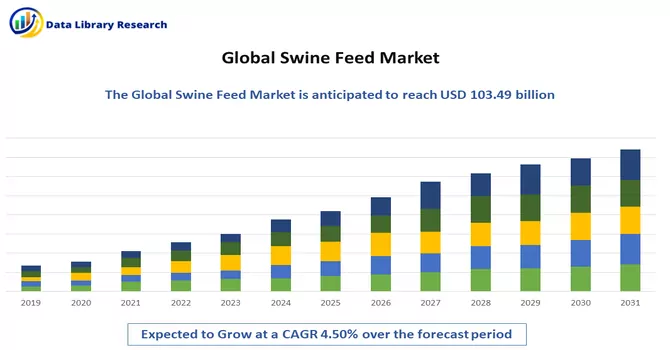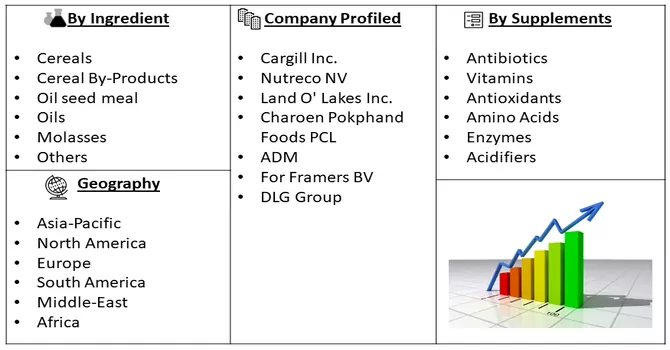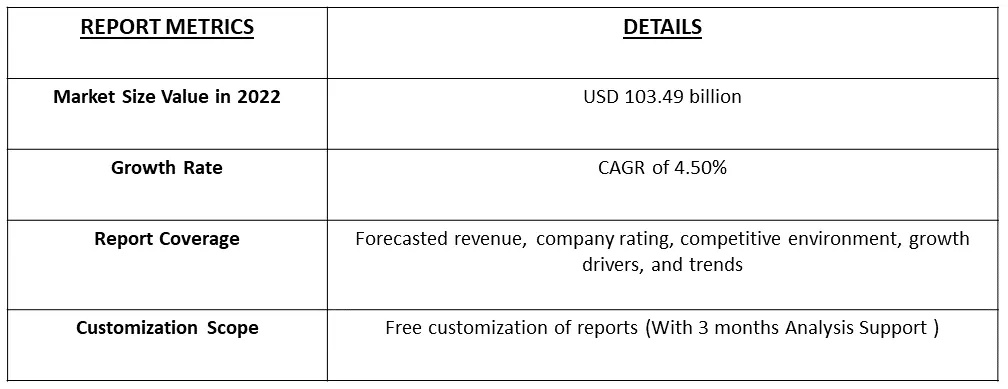The Swine Feed Market size is expected to grow from USD 103.49 billion in 2022 registering a CAGR of 4.50% during the forecast period (2023-2028).

Get Complete Analysis Of The Report - Download Free Sample PDF
Research and development efforts are ongoing to improve feed efficiency and growth rates in swine. Feed additives like enzymes, probiotics, and prebiotics are increasingly utilized to optimize nutrient utilization.
Feeding systems for swine involve feed type and form, as well as how it is supplied to the pigs. The main type of feed for swine in the United States is in dry form, where the cereal grain has been ground and mixed with other dry ingredients to form a complete feed.
With sustainability concerns and fluctuating feed ingredient prices, there is a rising interest in alternative protein sources for swine feed. Insect meal, algae, and single-cell proteins are being explored as viable substitutes for traditional protein sources like soybean meal.
Segmentation:
The Swine Feed Market is Segmented
By Ingredient :
Supplements :
Geography
The report offers market estimation and forecasts in value (USD million) for the above-mentioned segments.

For Detailed Market Segmentation - Download Free Sample PDF
Drivers:
Changing Diet Patterns of the Populations, Particularly in Developing Markets
Swine livestock production has been growing across the world to support the needs of the changing diet patterns of the populations, particularly in developing markets. In addition to the growing demand for animal protein and the industrialization of livestock production, other factors driving the swine feed market include the increasing focus on animal welfare and sustainability. Consumers are becoming more concerned about the origin and quality of their food, leading to a rise in demand for products from animals raised in humane and sustainable conditions. This trend is driving the adoption of new feeding practices and technologies that promote animal welfare and reduce environmental impacts. There is a growing emphasis on precision nutrition, tailoring swine diets to meet specific growth stages and health requirements. Precision feeding utilizes data analytics and technology to optimize nutrient composition, resulting in improved feed efficiency and cost-effectiveness.
High Awareness, the Growing Demand for Animal Nutrition, and the Ban of Antibiotics
Increasing awareness among swine producers and consumers about the importance of animal nutrition is a significant driver for the swine feed market. Producers are recognizing that a well-balanced diet can enhance swine health, growth, and overall performance. This heightened awareness is driving the demand for specialized swine feed formulations tailored to different growth stages and health needs. Thus, the increasing awareness for animal nutrition is expected to drive the growth of the studied market over the forecast period.
Restraints :
Swine Feed Market High Cost of Food Products
The swine feed market presents numerous opportunities and is evolving to meet new demands, it also faces several significant restraints and challenges. Understanding these restraints is crucial for stakeholders to develop effective strategies and solutions. The prices of key feed ingredients, such as corn, soybean meal, and wheat, are subject to market fluctuations. Sudden price increases can impact feed production costs, leading to higher prices for swine feed. Thus, such instances are slowing down the growth of the studied market over the forecast period.
The COVID-19 pandemic led to disruptions in the supply chain, affecting the sourcing and transportation of key feed ingredients. Restrictions on movement and border closures hindered the timely delivery of essential raw materials to feed manufacturers. For instance, an article published by the National Center for Biotechnology Information reported that lockdowns, quarantines, and health concerns led to labor shortages in feed production facilities and on farms. Reduced workforce availability affected feed manufacturing, distribution, and on-farm operations. Thus, such instances report that initially the market was impacted. However, in the current scenario, it is anticipated that with the adoption of digital technologies for remote monitoring and management of swine farms. This allowed for more efficient feed management and reduced the need for on-site personnel. Thus, with the rapid technological development, the market is anticipated to witness significant growth over the forecast period
Segmental Analysis:
Antibiotic Segment is Expected to Witness Significant Growth Over the Forecast Period
Antibiotics used to prevent, treat, and control bacterial infections in livestock are called animal vaccines. The recent developments by the top major players are expected to drive the growth of the studied segment. For instance, in July 2021, Virbac announced the launch of Tulissin 25 (tulathromycin injection) injectable solution and Tulissin 100 (tulathromycin injection) injectable solution for use in cattle and swine in the market.
Cereals Segment is Expected to Witness Significant growth Over the Forecast Period
Cereals have always been a major part of swine food. Breakfast cereal manufacturers are using the nutritional plank as a growth strategy. Furthermore, the recent developments by the top manufacturers are driving the growth of the studied market. For instance, In October 2020, Limagrain Ingredients opened its new production line in France. With an investment of USD 9 million, the company expanded its existing facility to increase the production of functional cereal flour and products to up to 15,000 tons. This sums up to a production capacity of 45,000 tons per year. Thus, such developments are fueling the growth of the studied segment.
Asia-Pacific Region is Expected to Witness Significant Growth Over the Forecast Period
Pork meat is the most preferred meat in the Asia-Pacific region due to its fat content and taste, and has been consumed in the region since ancient times. The region is the largest market for swine feed products due to the huge pork meat consumption. South East Asia is the world’s largest producer and exporter of pork, followed by Europe and North America. China is the primary market for pork production, followed by Vietnam, Thailand, South Korea, Japan, and the Philippines. Japan, South Korea, and Taiwan are the saturated markets for pork consumption, while Vietnam and the Philippines are emerging markets.
China holds the topmost position in terms of compound feed consumption, driven by factors such as the increasing consumption of pork, rising income among the middle-class population, and urbanization. Consequently, the increased demand for meat and rising costs of raw materials for animal consumption drive the demand for swine feed.
In 2021, China had around 454.8 million swine population, accounting for more than 50% of the region. The demand is also generated from the processed meat industry, which is growing at a healthy rate and requires high-quality pork meat. The adoption of intensive livestock farming systems is expected to help maintain a steady growth rate. Thus, due to the above-mentioned reasons, the region is expected to witness significant growth over the forecast period.

Get Complete Analysis Of The Report - Download Free Sample PDF
Major companies are adopting strategies, such as mergers and acquisitions, expansion, and partnerships, to increase their market shares. The leading companies are focused on acquiring feed mills and small manufacturing facilities for the expansion of their businesses in domestic and international markets. The global swine feed market is slightly consolidated with major players like:
Key Players :
Recent Development:
1. January 2023: Cargill expanded their partnership with BASF in the animal nutrition business, adding research and development capabilities and new markets to the partners’ existing feed enzyme distribution agreements. This partnership helped develop, produce, market, and sell customer-centric enzyme products and solutions for animals, including swine.
2. May 2022: ADM company acquired a feed mill in Polomolok, South Cotabato, from South Sunrays Milling Corporation. The acquisition helps in providing a wide range of products to meet Asia's demand in the animal nutrition market.
Q1. What is the current Swine Feed Market size ?
The Swine Feed Market size is expected to grow from USD 103.49 billion.
Q2. What is the Growth Rate of the Swine Feed Market?
Swine Feed Market is registering a CAGR of 4.50% during the forecast period.
Q3. What segments are covered in the Swine Feed Market Report?
By Ingredient, By Supplement & Geography these segments are covered in the Swine Feed Market Report.
Q4. Which are the major companies in the Swine Feed Market?
Cargill Inc., Nutreco NV, Land O' Lakes Inc. and Charoen Pokphand Foods PCL are some of the major companies in the Swine Feed Market.
Data Library Research are conducted by industry experts who offer insight on industry structure, market segmentations technology assessment and competitive landscape (CL), and penetration, as well as on emerging trends. Their analysis is based on primary interviews (~ 80%) and secondary research (~ 20%) as well as years of professional expertise in their respective industries. Adding to this, by analysing historical trends and current market positions, our analysts predict where the market will be headed for the next five years. Furthermore, the varying trends of segment & categories geographically presented are also studied and the estimated based on the primary & secondary research.
In this particular report from the supply side Data Library Research has conducted primary surveys (interviews) with the key level executives (VP, CEO’s, Marketing Director, Business Development Manager and SOFT) of the companies that active & prominent as well as the midsized organization
FIGURE 1: DLR RESEARH PROCESS

Extensive primary research was conducted to gain a deeper insight of the market and industry performance. The analysis is based on both primary and secondary research as well as years of professional expertise in the respective industries.
In addition to analysing current and historical trends, our analysts predict where the market is headed over the next five years.
It varies by segment for these categories geographically presented in the list of market tables. Speaking about this particular report we have conducted primary surveys (interviews) with the key level executives (VP, CEO’s, Marketing Director, Business Development Manager and many more) of the major players active in the market.
Secondary ResearchSecondary research was mainly used to collect and identify information useful for the extensive, technical, market-oriented, and Friend’s study of the Global Extra Neutral Alcohol. It was also used to obtain key information about major players, market classification and segmentation according to the industry trends, geographical markets, and developments related to the market and technology perspectives. For this study, analysts have gathered information from various credible sources, such as annual reports, sec filings, journals, white papers, SOFT presentations, and company web sites.
Market Size EstimationBoth, top-down and bottom-up approaches were used to estimate and validate the size of the Global market and to estimate the size of various other dependent submarkets in the overall Extra Neutral Alcohol. The key players in the market were identified through secondary research and their market contributions in the respective geographies were determined through primary and secondary research.
Forecast Model
